Ginkgo biloba
| Ginkgo biloba | |
|---|---|
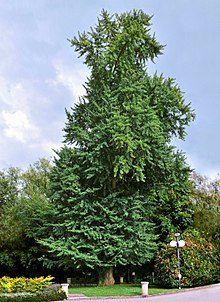
| |
| Mature tree | |
| Scientific classification | |
| Missing taxonomy template (fix): | Ginkgo biloba |
| Binomial name | |
| Ginkgo biloba | |
Ginkgo (Ginkgo biloba; Chinese: 銀杏; pinyin: yínxìng; Japanese pronunciation: ichō, ginnan; Korean: 은행; romaja: eunhaeng; Vietnamese: bạch quả), acceptable variant gingko[3] and also known as the maidenhair tree, is a unique species of tree and is the only extant taxon in the division Ginkgophyta. The ginkgo is a living fossil, recognizably similar to fossils dating back 270 million years. Native to China,[4] the tree is widely cultivated and was introduced early to human history. It has various uses in traditional medicine and as a source of food.
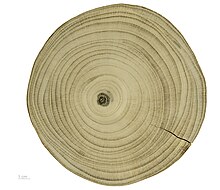
Description
Ginkgos are large trees, normally reaching a height of 20–35 m (66–115 feet), with some specimens in China being over 50 m (164 feet). The tree has an angular crown and long, somewhat erratic branches, and is usually deep rooted and resistant to wind and snow damage. Young trees are often tall and slender, and sparsely branched; the crown becomes broader as the tree ages. During autumn, the leaves turn a bright yellow, then fall, sometimes within a short space of time (one to 15 days). A combination of resistance to disease, insect-resistant wood and the ability to form aerial roots and sprouts makes ginkgos long-lived, with some specimens claimed to be more than 2,500 years old.
Ginkgo is a relatively shade-intolerant species that (at least in cultivation) grows best in environments that are well-watered and well-drained. The species shows a preference for disturbed sites; in the "semiwild" stands at Tian Mu Shan, many specimens are found along stream banks, rocky slopes, and cliff edges. Accordingly, ginkgo retains a prodigious capacity for vegetative growth. It is capable of sprouting from embedded buds near the base of the trunk (lignotubers, or basal chi chi) in response to disturbances, such as soil erosion. Old individuals are also capable of producing aerial roots on the undersides of large branches in response to disturbances such as crown damage; these roots can lead to successful clonal reproduction upon contacting the soil. These strategies are evidently important in the persistence of ginkgo; in a survey of the "semiwild" stands remaining in Tianmushan, 40% of the specimens surveyed were multistemmed, and few saplings were present.[5]: 86–87
Branches
Ginkgo branches grow in length by growth of shoots with regularly spaced leaves, as seen on most trees. From the axils of these leaves, "spur shoots" (also known as short shoots) develop on second-year growth. Short shoots have very short internodes (so they may grow only one or two centimeters in several years) and their leaves are usually unlobed. They are short and knobby, and are arranged regularly on the branches except on first-year growth. Because of the short internodes, leaves appear to be clustered at the tips of short shoots, and reproductive structures are formed only on them (see pictures below - seeds and leaves are visible on short shoots). In ginkgos, as in other plants that possess them, short shoots allow the formation of new leaves in the older parts of the crown. After a number of years, a short shoot may change into a long (ordinary) shoot, or vice versa.[citation needed]
Leaves


The leaves are unique among seed plants, being fan-shaped with veins radiating out into the leaf blade, sometimes bifurcating (splitting), but never anastomosing to form a network.[6] Two veins enter the leaf blade at the base and fork repeatedly in two; this is known as dichotomous venation. The leaves are usually 5–10 cm (2–4 in), but sometimes up to 15 cm (6 in) long. The old popular name "maidenhair tree" is because the leaves resemble some of the pinnae of the maidenhair fern, Adiantum capillus-veneris. Ginkgos are prized for their autumn foliage, which is a deep saffron yellow.
Leaves of long shoots are usually notched or lobed, but only from the outer surface, between the veins. They are borne both on the more rapidly growing branch tips, where they are alternate and spaced out, and also on the short, stubby spur shoots, where they are clustered at the tips.
Reproduction
Ginkgos are dioecious, with separate sexes, some trees being female and others being male. Male plants produce small pollen cones with sporophylls, each bearing two microsporangia spirally arranged around a central axis.
Female plants do not produce cones. Two ovules are formed at the end of a stalk, and after pollination, one or both develop into seeds. The seed is 1.5–2 cm long. Its fleshy outer layer (the sarcotesta) is light yellow-brown, soft, and fruit-like. It is attractive in appearance, but contains butyric acid[7] (also known as butanoic acid) and smells like rancid butter or vomit[8] when fallen. Beneath the sarcotesta is the hard sclerotesta (the "shell" of the seed) and a papery endotesta, with the nucellus surrounding the female gametophyte at the center.[9]
The fertilization of ginkgo seeds occurs via motile sperm, as in cycads, ferns, mosses and algae. The sperm are large (about 70–90 micrometres)[10] and are similar to the sperm of cycads, which are slightly larger. Ginkgo sperm were first discovered by the Japanese botanist Sakugoro Hirase in 1896.[11] The sperm have a complex multi-layered structure, which is a continuous belt of basal bodies that form the base of several thousand flagella which actually have a cilia-like motion. The flagella/cilia apparatus pulls the body of the sperm forwards. The sperm have only a tiny distance to travel to the archegonia, of which there are usually two or three. Two sperm are produced, one of which successfully fertilizes the ovule. Although it is widely held that fertilization of ginkgo seeds occurs just before or after they fall in early autumn,[6][9] embryos ordinarily occur in seeds just before and after they drop from the tree.[12]
-
Trunk bark
-
Ginkgo pollen-bearing cones
-
Ovules ready for fertilization
-
Female gametophyte, dissected from a seed freshly shed from the tree, containing a well-developed embryo
-
Immature ginkgo ovules and leaves
-
Autumn leaves and fallen seeds
-
A forest of saplings sprout among last year's seeds
-
Ginkgo tree in autumn
-
Fruit on tree
Distribution and habitat
Although Ginkgo biloba and other species of the genus were once widespread throughout the world, its range shrank until by two million years ago, it was restricted to a small area of China. For centuries, it was thought to be extinct in the wild, but is now known to grow in at least two small areas in Zhejiang province in eastern China, in the Tianmushan Reserve. However, recent studies indicate high genetic uniformity among ginkgo trees from these areas, arguing against a natural origin of these populations and suggesting the ginkgo trees in these areas may have been planted and preserved by Chinese monks over a period of about 1,000 years.[13] This study demonstrates a greater genetic diversity in Southwestern China populations, supporting glacial refugia in mountains surrounding eastern Qinghai-Tibet Plateau, where several old-growth candidates for wild populations have been reported.[13][14] Whether native ginkgo populations still exist has not been demonstrated unequivocally, but evidence grows favouring these Southwestern populations as wild, from genetic data but also from history of those territories, with bigger Ginkgo biloba trees being older than surrounding human settlements.[13]
Where it occurs in the wild, it is found infrequently in deciduous forests and valleys on acidic loess (i.e. fine, silty soil) with good drainage. The soil it inhabits is typically in the pH range of 5.0 to 5.5.[15]
In many areas of China, it has been long cultivated, and it is common in the southern third of the country.[15] It has also been commonly cultivated in North America for over 200 years and in Europe for close to 300, but during that time, it has never become significantly naturalized.[16]
Taxonomy and naming
The species was initially described by Linnaeus in 1771, the specific epithet biloba derived from the Latin bis, "two" and loba, "lobed", referring to the shape of the leaves.[17] Two names for the species recognise the botanist Richard Salisbury, a placement by Nelson as Pterophyllus salisburiensis and the earlier Salisburia adiantifolia proposed by James Edward Smith. The epithet of the latter may have been intended to denote a characteristic resembling Adiantum, the genus of maidenhair ferns.[18]
The relationship of ginkgo to other plant groups remains uncertain. It has been placed loosely in the divisions Spermatophyta and Pinophyta, but no consensus has been reached. Since its seeds are not protected by an ovary wall, it can morphologically be considered a gymnosperm. The apricot-like structures produced by female ginkgo trees are technically not fruits, but are seeds that have a shell consisting of a soft and fleshy section (the sarcotesta), and a hard section (the sclerotesta).
The ginkgo is classified in its own division, the Ginkgophyta, comprising the single class Ginkgoopsida, order Ginkgoales, family Ginkgoaceae, genus Ginkgo and is the only extant species within this group. It is one of the best-known examples of a living fossil, because Ginkgoales other than G. biloba are not known from the fossil record after the Pliocene.[19][20]
Etymology
The older Chinese name for this plant is 銀果, meaning "silver fruit", pronounced yínguǒ in Mandarin or Ngan-gwo in Cantonese. The most usual names today are 白果 (bái guǒ), meaning "white fruit", and 銀杏 (yínxìng), meaning "silver apricot". The former name was borrowed directly in Vietnamese as bạch quả. The latter name was borrowed in Japanese ぎんなん (ginnan) and Korean 은행 (eunhaeng), when the tree itself was introduced from China.
The scientific name Ginkgo is the result of a spelling error that occurred three centuries ago. Kanji typically have multiple pronunciations in Japanese, and the characters 銀杏 used for ginnan can also be pronounced ginkyō. Engelbert Kaempfer, the first Westerner to investigate the species in 1690, wrote down this pronunciation in the notes that he later used for the Amoenitates Exoticae (1712) with the "awkward" spelling "ginkgo".[21] This appears to be a simple error of Kaempfer, taking his spelling of other Japanese words containing the syllable "kyō" into account, a more precise romanization following his writing habits would have been "ginkio" or "ginkjo".[22] Linné, who relied on Kaempfer when dealing with Japanese plants adopted the spelling given in Kaempfer's "Flora Japonica" (Amoenitates Exoticae, p. 811).
Palaeontology

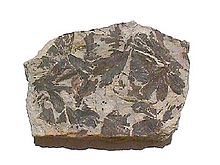
The ginkgo is a living fossil, with fossils recognisably related to modern ginkgo from the Permian, dating back 270 million years. The most plausible ancestral group for the order Ginkgoales is the Pteridospermatophyta, also known as the "seed ferns", specifically the order Peltaspermales. The closest living relatives of the clade are the cycads,[5]: 84 which share with the extant G. biloba the characteristic of motile sperm. Fossils attributable to the genus Ginkgo first appeared in the Early Jurassic, and the genus diversified and spread throughout Laurasia during the middle Jurassic and Early Cretaceous. It declined in diversity as the Cretaceous progressed, and by the Paleocene, Ginkgo adiantoides was the only Ginkgo species left in the Northern Hemisphere, while a markedly different (and poorly documented) form persisted in the Southern Hemisphere. At the end of the Pliocene, Ginkgo fossils disappeared from the fossil record everywhere except in a small area of central China, where the modern species survived. It is doubtful whether the Northern Hemisphere fossil species of Ginkgo can be reliably distinguished. Given the slow pace of evolution and morphological similarity between members of the genus, there may have been only one or two species existing in the Northern Hemisphere through the entirety of the Cenozoic: present-day G. biloba (including G. adiantoides) and G. gardneri from the Paleocene of Scotland.[5]: 85
At least morphologically, G. gardneri and the Southern Hemisphere species are the only known post-Jurassic taxa that can be unequivocally recognised. The remainder may have been ecotypes or subspecies. The implications would be that G. biloba had occurred over an extremely wide range, had remarkable genetic flexibility and, though evolving genetically, never showed much speciation. While it may seem improbable that a species may exist as a contiguous entity for many millions of years, many of the ginkgo's life-history parameters fit. These are: extreme longevity; slow reproduction rate; (in Cenozoic and later times) a wide, apparently contiguous, but steadily contracting distribution coupled with, as far as can be demonstrated from the fossil record, extreme ecological conservatism (restriction to disturbed streamside environments).[5]: 91
Modern-day G. biloba grows best in environments that are well-watered and drained,[5]: 87 and the extremely similar fossil Ginkgo favored similar environments: the sediment record at the majority of fossil Ginkgo localities indicates it grew primarily in disturbed environments along streams and levees.[5] Ginkgo, therefore, presents an "ecological paradox" because while it possesses some favorable traits for living in disturbed environments (clonal reproduction) many of its other life-history traits (slow growth, large seed size, late reproductive maturity) are the opposite of those exhibited by modern plants that thrive in disturbed settings.[5]: 92
Given the slow rate of evolution of the genus, Ginkgo possibly represents a preangiosperm strategy for survival in disturbed streamside environments. Ginkgo evolved in an era before flowering plants, when ferns, cycads, and cycadeoids dominated disturbed streamside environments, forming low, open, shrubby canopies. Ginkgo's large seeds and habit of "bolting" - growing to a height of 10 m before elongating its side branches - may be adaptions to such an environment. Because diversity in the genus Ginkgo drops through the Cretaceous (along with that of ferns, cycads, and cycadeoids) at the same time the flowering plants were on the rise, the notion that flowering plants with better adaptations to disturbance displaced Ginkgo and its associates over time is supported.[5]: 93
Ginkgo has been used for classifying plants with leaves that have more than four veins per segment, while Baiera for those with fewer than four veins per segment. Sphenobaiera has been used to classify plants with a broadly wedge-shaped leaf that lacks a distinct leaf stem. Trichopitys is distinguished by having multiple-forked leaves with cylindrical (not flattened), thread-like ultimate divisions; it is one of the earliest fossils ascribed to the Ginkgophyta. [citation needed]

-
Extant Ginkgo biloba[23]
Cultivation and uses

Ginkgo has long been cultivated in China; some planted trees at temples are believed to be over 1,500 years old. The first record of Europeans encountering it is in 1690 in Japanese temple gardens, where the tree was seen by the German botanist Engelbert Kaempfer. Because of its status in Buddhism and Confucianism, the ginkgo is also widely planted in Korea and parts of Japan; in both areas, some naturalization has occurred, with ginkgos seeding into natural forests.
In some areas, most intentionally planted ginkgos are male cultivars grafted onto plants propagated from seed, because the male trees will not produce the malodorous seeds. The popular cultivar "Autumn Gold" is a clone of a male plant.
The disadvantage of male Ginkgo biloba trees is that they are highly allergenic. Male Ginkgo biloba trees have an OPALS allergy scale rating of 7 (out of 10), whereas female trees, which can produce no pollen, have an OPALS allergy scale rating of 2.[24]
Female cultivars include "Liberty Splendor", "Santa Cruz", and "Golden Girl", so named because of the striking yellow color of its leaves in the fall.
Ginkgos adapt well to the urban environment, tolerating pollution and confined soil spaces.[25] They rarely suffer disease problems, even in urban conditions, and are attacked by few insects.[26][27] For this reason, and for their general beauty, ginkgos are excellent urban and shade trees, and are widely planted along many streets.[28]
Ginkgos are also popular subjects for growing as penjing and bonsai;[29] they can be kept artificially small and tended over centuries. Furthermore, the trees are easy to propagate from seed.
The ginkgo leaf is the symbol of the Urasenke school of Japanese tea ceremony. The tree is the official tree of the Japanese capital of Tokyo, and the symbol of Tokyo is a ginkgo leaf.
Hiroshima
Extreme examples of the ginkgo's tenacity may be seen in Hiroshima, Japan, where six trees growing between 1–2 km from the 1945 atom bomb explosion were among the few living things in the area to survive the blast. Although almost all other plants (and animals) in the area were killed, the ginkgos, though charred, survived and were soon healthy again. The six trees are still alive: they are marked with signs at Housenbou (報専坊) temple (planted in 1850), Shukkei-en (planted about 1740), Jōsei-ji (planted 1900), at the former site of Senda Elementary School near Miyukibashi, at Myōjōin temple, and an Edo period-cutting at Anraku-ji [30]
Culinary use


The nut-like gametophytes inside the seeds are particularly esteemed in Asia, and are a traditional Chinese food. Ginkgo nuts are used in congee, and are often served at special occasions such as weddings and the Chinese New Year (as part of the vegetarian dish called Buddha's delight). In Chinese culture, they are believed to have health benefits; some also consider them to have aphrodisiac qualities. Japanese cooks add ginkgo seeds (called ginnan) to dishes such as chawanmushi, and cooked seeds are often eaten along with other dishes.
When eaten in large quantities or over a long period, especially by children[31] the gametophyte (meat) of the seed can cause poisoning by 4'-O-methylpyridoxine (MPN). MPN is heat stable and not destroyed by cooking.[31] Studies have demonstrated the convulsions caused by MPN can be prevented or terminated with pyridoxine.
Some people are sensitive to the chemicals in the sarcotesta, the outer fleshy coating. These people should handle the seeds with care when preparing the seeds for consumption, wearing disposable gloves. The symptoms are allergic contact dermatitis[32][33] or blisters similar to that caused by contact with poison ivy. However, seeds with the fleshy coating removed are mostly[clarification needed][quantify] safe to handle.
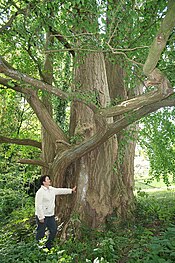
Health effects of extracts and supplements
In studies, Ginkgo biloba or its components have been shown to promote proliferation of neural stem cells[34]; prevent or reduce brain damage after an induced stroke[35]; significantly improve verbal recall in people with age-associated memory impairment[36]; have preventative effects for cancerous human brain and breast tumours[37]; and be beneficial for symptoms of MS[38].
Ginkgo is marketed in dietary supplement form with claims it can enhance cognitive function in people without known cognitive problems, but such claims are unfounded because it has no effect on memory or attention in healthy people.[39][40]
Ginkgo has been studied as a possible treatment for dementia and Alzheimer's disease, with mixed results. Some reviews have concluded there is no good evidence supporting the use of Ginkgo in dementia,[41][42][43] whereas others have concluded that the EGB761 extract may help patients with dementia.[44][45] The 2008 "GEM" study concluded that as a preventative toward the onset of Alzheimers, Gingko was "ineffective in slowing cognitive decline".[40]
There is no good evidence supporting the use of Ginkgo for treating high blood pressure,[46] menopause-related cognitive decline,[47] tinnitus,[48] post-stroke recovery,[49] peripheral arterial disease,[50] macular degeneration,[51] or altitude sickness.[52][53]
Side effects

Ginkgo may have undesirable effects, especially for individuals with blood circulation disorders and those taking anticoagulants such as aspirin or warfarin, although recent studies have found ginkgo has little or no effect on the anticoagulant properties or pharmacodynamics of warfarin in healthy subjects.[54][55] Ginkgo inhibits monoamine oxidase,[56] so people who are taking certain types of antidepressants (such as monoamine oxidase inhibitors and selective serotonin reuptake inhibitor) may experience side effects including an increased risk of developing serotonin syndrome, a life-threatening condition.[55][57]
Additional side effects include increased risk of bleeding, gastrointestinal discomfort, nausea, vomiting, diarrhea, headaches, dizziness, heart palpitations, and restlessness.[55][57][58] Ginkgo should be used with caution when combined with other herbs known to increase bleeding (e.g. garlic, ginseng, ginger).
According to a systemic review, the effects of ginkgo on pregnant women may include increased bleeding time, and should be avoided during lactation due to inadequate safety evidence.[59]
Allergic precautions and contraindications
Some authors claim that Ginkgo biloba extracts, which are co-administered with anticoagulant drugs such as warfarin or coumadin, increase the risk for bleeding due to their assumed antiplatelet activity. Concerns that standardized Ginkgo biloba preparations (GBE) significantly impact haemostasis or adversely affect the safety of anticoagulant drugs are however not supported by current medical literature.[60]
The presence of amentoflavone in G. biloba leaves would indicate a potential for interactions with many medications through the strong inhibition of CYP3A4 and CYP2C9; however, no empirical evidence supports this. Further, at recommended doses, studies have shown, "[m]ultiple-dose administration of Ginkgo biloba did not affect cytochrome P-450 2D6 or 3A4 activity in normal volunteers."[61] The concentration of amentoflavone found even in commercial ginkgo extracts possibly is too low to be pharmacologically active.
Ginkgo biloba leaves and sarcotesta also contain ginkgolic acids,[62] which are highly allergenic, long-chain alkylphenols such as bilobol or adipostatin A[63] (bilobol is a substance related to anacardic acid from cashew nut shells and urushiols present in poison ivy and other Toxicodendron spp.)[33] Individuals with a history of strong allergic reactions to poison ivy, mangoes, cashews and other alkylphenol-producing plants are more likely to experience allergic reaction when consuming non-standardized ginkgo-containing preparations, combinations, or extracts thereof. The level of these allergens in standardized pharmaceutical preparations from Ginkgo biloba was restricted to 5 ppm by the Commission E of the former Federal German Health Authority.
Review of chemicals in G. biloba
Extracts of ginkgo leaves contain flavonoid glycosides (myricetin and quercetin)[64] and terpenoids (ginkgolides, bilobalides).
The plant also contains biflavones[65] Important constituents present in the medicinally used leaves are the terpene trilactones, i.e., ginkgolides A, B, C, J and bilobalide, many flavonol glycosides, biflavones, proanthocyanidins, alkylphenols, simple phenolic acids, 6-Hydroxykynurenic acid, 4-O-methylpyridoxine and polyprenols.[66]
See also
- André Michaux, introduced the ginkgo to North America
- Ginkgo/Wanapum State Park in central Washington, USA
- Herbalism
- List of edible seeds
References
- ^ Mustoe, G.E. (2002). "Eocene Ginkgo leaf fossils from the Pacific Northwest". Canadian Journal of Botany. 80 (10): 1078–1087. doi:10.1139/b02-097.
- ^ Template:IUCN2006 Listed as Endangered (EN B1+2c v2.3)
- ^ "Gingko: Variant of ginkgo." American Heritage Dictionary (3d ed. 1992), p. 767
- ^ ginkgo
- ^ a b c d e f g h Royer, Dana L.; Hickey, Leo J.; Wing, Scott L. (2003). "Ecological conservatism in the 'living fossil' Ginkgo". Paleobiology. 29 (1): 84–104. doi:10.1666/0094-8373(2003)029<0084:ECITLF>2.0.CO;2. ISSN 0094-8373.
- ^ a b Ginkgoales: More on Morphology
- ^ Raven, Peter H.; Ray F. Evert; Susan E. Eichhorn (2005). Biology of Plants (7th ed.). New York: W. H. Freeman and Company. pp. 429–430. ISBN 0-7167-1007-2.
{{cite book}}: CS1 maint: multiple names: authors list (link) - ^ Plotnik, Arthur (2000). The Urban Tree Book: An Uncommon Field Guide for City and Town (1st ed.). New York: Three Rivers Press. p. 202. ISBN 0-8129-3103-3.
- ^ a b Laboratory IX -- Ginkgo, Cordaites, and the Conifers
- ^ Vanbeek A. Vanbeek (2000). Ginkgo Biloba (Medicinal and Aromatic Plants: Industrial Profiles). CRC Press. p. 37. ISBN 90-5702-488-8.
- ^ History of Discovery of Spermatozoids In Ginkgo biloba and Cycas revoluta[dead link]
- ^ Holt, B. F.; Rothwell, G. W. (1997). "Is Ginkgo biloba (Ginkgoaceae) Really an Oviparous Plant?". American Journal of Botany. 84 (6): 870–872. doi:10.2307/2445823. JSTOR 2445823.
- ^ a b c Shen, L; Chen, X-Y; Zhang, X; Li, Y-Y; Fu, C-X; Qiu, Y-X (2004). "Genetic variation of Ginkgo biloba L. (Ginkgoaceae) based on cpDNA PCR-RFLPs: inference of glacial refugia". Heredity. 94 (4): 396–401. doi:10.1038/sj.hdy.6800616. PMID 15536482.
- ^ Tang, CQ; al, et (2012). "Evidence for the persistence of wild Ginkgo biloba (Ginkgoaceae) populations in the Dalou Mountains, southwestern China". American Journal of Botany. 99 (8): 1408–1414. doi:10.3732/ajb.1200168. PMID 22847538.
- ^ a b Fu, Liguo; Li, Nan; Mill, Robert R. (1999). "Ginkgo biloba". In Wu, Z. Y.; Raven, P.H.; Hong, D.Y. (ed.). Flora of China. Vol. 4. Beijing: Science Press; St. Louis: Missouri Botanical Garden Press. p. 8.
{{cite book}}: CS1 maint: multiple names: authors list (link) - ^ Whetstone, R. David (2006). "Ginkgo biloba". In Flora of North America Editorial Committee, eds. 1993+ (ed.). Flora of North America. Vol. 2. New York & Oxford: Oxford University Press.
{{cite book}}: CS1 maint: numeric names: editors list (link) - ^ Simpson DP (1979). Cassell's Latin Dictionary (5 ed.). London: Cassell Ltd. p. 883. ISBN 0-304-52257-0.
- ^ Chandler, Brian (2000). "Ginkgo - origins". Ginkgo pages. Retrieved 22 November 2010.
- ^ Zhou, Zhiyan; Zheng, Shaolin (2003). "Palaeobiology: The missing link in Ginkgo evolution". Nature. 423 (6942): 821–2. doi:10.1038/423821a. PMID 12815417.
- ^ Julie Jalalpour, Matt Malkin, Peter Poon, Liz Rehrmann, Jerry Yu (1997). "Ginkgoales: Fossil Record". University of California, Berkeley. Retrieved 3 June 2008.
{{cite web}}: CS1 maint: multiple names: authors list (link) - ^ Engelbert Kaempfer (1721). Amoenitates exoticae politico-physico-medicae (in Latin). Lengoviae: Meyer.
- ^ Wolfgang Michel: On Engelbert Kaempfer’s "Ginkgo". Research Notes, 2005/2011
- ^ a b c d Approximate reconstructions by B. M. Begović Bego and Z. Zhou, 2010/2011. Source: B.M. Begović Bego, (2011). Nature's Miracle Ginkgo biloba, Book 1, Vols. 1–2, pp. 60–61.
- ^ Ogren, Thomas Leo (2000). Allergy-Free Gardening. Berkeley, California: Ten Speed Press. p. 112. ISBN 1-58008-166-5.
- ^ Gilman, Edward F. and Dennis G. Watson (1993). "Ginkgo biloba 'Autumn Gold'" (PDF). US Forest Service. Retrieved 29 March 2008.[dead link]
- ^ Boland, Timothy, Laura E. Coit, Marty Hair (2002). Michigan Gardener's Guide. Cool Springs Press. ISBN 1-930604-20-3.
{{cite book}}: CS1 maint: multiple names: authors list (link) - ^ "Examples of Plants with Insect and Disease Tolerance". SULIS - Sustainable Urban Landscape Information Series. University of Minnesota. Retrieved 29 March 2008.
- ^ Ginkgo biloba trees in Barcelona (189 by 2015)
- ^ D'Cruz, Mark. "Ma-Ke Bonsai Care Guide for Ginkgo biloba". Ma-Ke Bonsai. Retrieved 2013-09-12.
- ^ "A-bombed Ginkgo trees in Hiroshima, Japan". The Ginkgo Pages.
- ^ a b Ginkgo Seed Poisoning. PEDIATRICS Vol. 109 No. 2 February 2002, pp. 325-327 [1]
- ^ Lepoittevin, J. -P.; Benezra, C.; Asakawa, Y. (1989). "Allergic contact dermatitis to Ginkgo biloba L.: relationship with urushiol". Archives of Dermatological Research. 281 (4): 227–30. doi:10.1007/BF00431055. PMID 2774654.
- ^ a b Schötz, Karl (2004). "Quantification of allergenic urushiols in extracts ofGinkgo biloba leaves, in simple one-step extracts and refined manufactured material(EGb 761)". Phytochemical Analysis. 15 (1): 1–8. doi:10.1002/pca.733. PMID 14979519.
- ^ Wang, Chen, and Wang (July 23, 2013). "A ginkgo biloba extract promotes proliferation of endogenous neural stem cells". eurekalert.org.
{{cite news}}: CS1 maint: multiple names: authors list (link) - ^ Doré, Saleem, Zhuang, and Biswal (October 9, 2008). "Mouse studies suggest daily dose of ginkgo may prevent brain cell damage after a stroke". .eurekalert.org.
{{cite news}}: CS1 maint: multiple names: authors list (link) - ^ Ercoli, Small; et al. (November 11, 2003). "UCLA Researchers Find Gingko Biloba May Help Improve Memory". sciencedaily.com.
{{cite news}}: Explicit use of et al. in:|last1=(help) - ^ Papadopoulos, Pretner, Amri, Li, Brown, Lin, Makariou; et al. (February 23, 2006). "Ginkgo Biloba Extract: More than Just for Memory? Animal Studies at Georgetown Find Ginkgo Biloba May Have Preventive Effects For Cancerous Human Brain and Breast Tumors". georgetown.edu.
{{cite news}}: Explicit use of et al. in:|last1=(help)CS1 maint: multiple names: authors list (link) - ^ Lovera; et al. (April 28, 2005). "OHSU Study Finds Ginkgo Beneficial For MS Symptoms". sciencedaily.com.
{{cite news}}: Explicit use of et al. in:|last1=(help) - ^ Laws KR, Sweetnam H, Kondel TK (November 2012). "Is Ginkgo biloba a cognitive enhancer in healthy individuals? A meta-analysis". Hum Psychopharmacol (Meta-analysis). 27 (6): 527–33. doi:10.1002/hup.2259. PMID 23001963.
{{cite journal}}: CS1 maint: multiple names: authors list (link) - ^ a b "Gingko". National Center for Complementary and Integrative Health, US National Institutes of Health. 2014. Retrieved 4 Sep 2014.
- ^ Birks, J; Grimley Evans, J (Jan 21, 2009). "Ginkgo biloba for cognitive impairment and dementia". The Cochrane database of systematic reviews (1): CD003120. doi:10.1002/14651858.CD003120.pub3. PMID 19160216.
- ^ Cooper, C; Li, R; Lyketsos, C; Livingston, G (Sep 2013). "Treatment for mild cognitive impairment: systematic review". The British journal of psychiatry : the journal of mental science. 203 (3): 255–64. doi:10.1192/bjp.bp.113.127811. PMID 24085737.
- ^ Mancuso, C; Siciliano, R; Barone, E; Preziosi, P (May 2012). "Natural substances and Alzheimer's disease: from preclinical studies to evidence based medicine". Biochimica et Biophysica Acta. 1822 (5): 616–24. doi:10.1016/j.bbadis.2011.09.004. PMID 21939756.
- ^ Weinmann, S; Roll, S; Schwarzbach, C; Vauth, C; Willich, SN (2010). "Effects of Ginkgo biloba in dementia: systematic review and meta-analysis". BMC geriatrics. 10: 14. doi:10.1186/1471-2318-10-14. PMC 2846949. PMID 20236541.
{{cite journal}}: CS1 maint: unflagged free DOI (link) - ^ Tan, MS; Yu, JT; Tan, CC; Wang, HF; Meng, XF; Wang, C; Jiang, T; Zhu, XC; Tan, L (Aug 11, 2014). "Efficacy and Adverse Effects of Ginkgo Biloba for Cognitive Impairment and Dementia: A Systematic Review and Meta-Analysis". Journal of Alzheimer's disease : JAD. doi:10.3233/JAD-140837. PMID 25114079.
- ^ Xiong XJ, Liu W, Yang XC; et al. (September 2014). "Ginkgo biloba extract for essential hypertension: A systemic review". Phytomedicine (Systematic review). 21 (10): 1131–1136. doi:10.1016/j.phymed.2014.04.024. PMID 24877716.
{{cite journal}}: Explicit use of et al. in:|author=(help)CS1 maint: multiple names: authors list (link) - ^ Clement, YN; Onakpoya, I; Hung, SK; Ernst, E (March 2011). "Effects of herbal and dietary supplements on cognition in menopause: a systematic review". Maturitas. 68 (3): 256–63. doi:10.1016/j.maturitas.2010.12.005. PMID 21237589.
- ^ Hilton, MP; Zimmermann, EF; Hunt, WT (Mar 28, 2013). "Ginkgo biloba for tinnitus". The Cochrane database of systematic reviews. 3: CD003852. doi:10.1002/14651858.CD003852.pub3. PMID 23543524.
- ^ Zeng X, Liu M, Yang Y, Li Y, Asplund K (2005). "Ginkgo biloba for acute ischaemic stroke". Cochrane Database Syst Rev (Systematic review) (4): CD003691. doi:10.1002/14651858.CD003691.pub2. PMID 16235335.
{{cite journal}}: CS1 maint: multiple names: authors list (link) - ^ Nicolaï SP, Kruidenier LM, Bendermacher BL; et al. (2013). "Ginkgo biloba for intermittent claudication". Cochrane Database Syst Rev (Systematic review). 6: CD006888. doi:10.1002/14651858.CD006888.pub3. PMID 23744597.
{{cite journal}}: Explicit use of et al. in:|author=(help)CS1 maint: multiple names: authors list (link) - ^ Evans, JR (Jan 31, 2013). "Ginkgo biloba extract for age-related macular degeneration". The Cochrane database of systematic reviews. 1: CD001775. doi:10.1002/14651858.CD001775.pub2. PMID 23440785.
- ^ Gertsch JH, Basnyat B, Johnson EW, Onopa J, Holck PS (Apr 3, 2004). "Randomised, double blind, placebo controlled comparison of ginkgo biloba and acetazolamide for prevention of acute mountain sickness among Himalayan trekkers: the prevention of high altitude illness trial (PHAIT)". BMJ. 797 (328(7443)): 797. doi:10.1136/bmj.38043.501690.7C. PMID 15070635.
{{cite journal}}: CS1 maint: multiple names: authors list (link) - ^ Seupaul, RA; Welch, JL; Malka, ST; Emmett, TW (April 2012). "Pharmacologic prophylaxis for acute mountain sickness: a systematic shortcut review". Annals of Emergency Medicine. 59 (4): 307–317.e1. doi:10.1016/j.annemergmed.2011.10.015. PMID 22153998.
- ^ Jiang X, Williams KM, Liauw WS, Ammit AJ, Roufogalis BD, Duke CC, Day RO, McLachlan AJ (April 2005). "Effect of ginkgo and ginger on the pharmacokinetics and pharmacodynamics of warfarin in healthy subjects". Br J Clin Pharmacol. 59 (4): 425–32. doi:10.1111/j.1365-2125.2005.02322.x. PMC 1884814. PMID 15801937.
{{cite journal}}: CS1 maint: multiple names: authors list (link) - ^ a b c "MedlinePlus Herbs and Supplements: Ginkgo (Ginkgo biloba L.)". National Institutes of Health. Retrieved 10 April 2008.
- ^ White HL, Scates PW, Cooper BR (1996). "Extracts of Ginkgo biloba leaves inhibit monoamine oxidase". Life Sci. 58 (16): 1315–21. doi:10.1016/0024-3205(96)00097-5. PMID 8614288.
{{cite journal}}: CS1 maint: multiple names: authors list (link) - ^ a b "Ginkgo biloba". University of Maryland Medical Center. Retrieved 10 April 2008.
- ^ Complete Ginkgo information from Drugs.com
- ^ Dugoua, J. J.; Mills, E.; Perri, D.; Koren, G. (2006). "Safety and efficacy of ginkgo (Ginkgo biloba) during pregnancy and lactation". Can J Clin Pharmacol. 13 (3): e277–84. PMID 17085776. Retrieved 28 October 2014.
- ^ Bone KM (2008). Mol Nutr Food Res. 52(7):764-71. doi: 10.1002/mnfr.200700098.PMID 18214851
- ^ Markowitz JS, Donovan JL, Lindsay DeVane C, Sipkes L, Chavin KD. Multiple-dose administration of Ginkgo biloba did not affect cytochrome P-450 2D6 or 3A4 activity in normal volunteers. J Clin Psychopharmacol. 2003 Dec;23(6):576-81. PubMed: 14624188
- ^ Xian-guo et al. (2000), "High-Performance Liquid Chromatography-Electrospray Ionization-Mass Spectrometry Study of Ginkgolic Acid in the Leaves and Fruits of the Ginkgo Tree (Ginkgo biloba)", Journal of Chromatographic Science 38 (4), pages 169-173. PubMed: 10766484[dead link]
- ^ Tanaka, A; Arai, Y; Kim, SN; Ham, J; Usuki, T (2011). "Synthesis and biological evaluation of bilobol and adipostatin A". Journal of Asian natural products research. 13 (4): 290–6. doi:10.1080/10286020.2011.554828. PMID 21462031.
- ^ Myricetin and quercetin, the flavonoid constituents ofGinkgobiloba extract, greatly reduce oxidative metabolism in both resting and Ca2+-loaded brain neurons. Yasuo Oyama, Paul A. Fuchs, Norihiro Katayama and Katsuhiko Noda, Brain Research, 28 January 1994, Volume 635, Issues 1–2, Pages 125–129, doi:10.1016/0006-8993(94)91431-1
- ^ Reversed-phase high-performance liquid chromatographic method for the analysis of biflavones in Ginkgo biloba L. extracts. Pietta P, Mauri P and Rava A, Journal of chromatography, 1988, vol. 437, no 2, pages 453-456, INIST 7067692
- ^ Chemical analysis of Ginkgo biloba leaves and extracts. Teris A van Beek, Journal of Chromatography A, 16 August 2002, Volume 967, Issue 1, Pages 21–55, doi:10.1016/S0021-9673(02)00172-3
Sources
- Royer, Dana L.; Hickey, Leo J.; Wing, Scott L. (2003). "Ecological conservatism in the 'living fossil' Ginkgo". Paleobiology. 29 (1): 84–104. doi:10.1666/0094-8373(2003)029<0084:ECITLF>2.0.CO;2. ISSN 0094-8373.
External links
- Growing Ginkgoes from seed[dead link]: by the Ottawa Horticultural Society
- Gymnosperm Database
- University of California Museum of Paleontology
- Ginkgo biloba information (Plants for a Future)
- Ginkgo: MedlinePlus Supplements - U.S. National Library of Medicine
- Ginkgo biloba Overview - University of Maryland Medical Center
- IUCN Red List endangered species
- Dioecious plants
- Endangered plants
- Endemic flora of China
- Garden plants of Asia
- Ginkgophyta
- Living fossils
- Medicinal plants of Asia
- Ornamental trees
- Plants used in Ayurveda
- Plants used in bonsai
- Trees of China
- Flora of Zhejiang
- Ypresian first appearances
- Foods requiring detoxification
- Allergenic foods


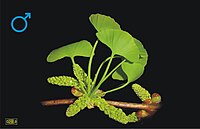
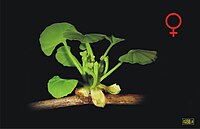


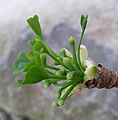






![Ginkgo yimaensis[23]](http://upload.wikimedia.org/wikipedia/commons/thumb/3/3f/Ginkgo_yimaensis.jpg/120px-Ginkgo_yimaensis.jpg)
![Ginkgo apodes[23]](http://upload.wikimedia.org/wikipedia/commons/thumb/a/a7/Ginkgo_apodes.jpg/120px-Ginkgo_apodes.jpg)
![Ginkgo adiantoides or a new taxon from the USA, G. cranei[23]](http://upload.wikimedia.org/wikipedia/commons/thumb/a/a1/Ginkgo_adiantoides_-_G._cranii.jpg/120px-Ginkgo_adiantoides_-_G._cranii.jpg)
![Extant Ginkgo biloba[23]](http://upload.wikimedia.org/wikipedia/commons/thumb/b/b0/Ginkgo_biloba_%28new_form%29.jpg/120px-Ginkgo_biloba_%28new_form%29.jpg)